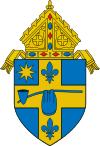Edward William O'Rourke
The Most Reverend Edward William O'Rourke | |
|---|---|
| Bishop of Peoria | |
| See | Peoria |
| Installed | May 24, 1971 |
| Term ended | January 22, 1990 |
| Predecessor | John Baptist Franz |
| Successor | John J. Myers |
| Other post(s) | Assistant chaplain at the Newman Centre of the University of Illinois at Urbana-Champaign Executive director of the National Catholic Rural Life Conference. |
| Orders | |
| Ordination | May 28, 1944 |
| Consecration | July 15, 1971 |
| Personal details | |
| Born | Edward William O'Rourke October 31, 1917 |
| Died | September 29, 1999 (aged 81) Peoria, Illinois |
| Denomination | Roman Catholic Church |
| Alma mater | St. Mary of the Lake Seminary |
Edward William O'Rourke (October 31, 1917 – September 29, 1999) was the sixth Roman Catholic Bishop of Peoria (1971–1990).
Biography
One of eleven children, Edward O'Rourke was born in Downs, Illinois, to Martin and Mary (née Hickey) O'Rourke.[1] He decided to become a priest following his Confirmation in 1930, and later recalled he "never had a moment of doubt that this was [his] calling."[1] After attending Downs High School (1931–1935) and St. Henry College (1935–1938), he studied at St. Mary of the Lake Seminary in Mundelein.[1] O'Rourke was ordained by Bishop Joseph H. Schlarman on May 28, 1944.[2] He then served as an assistant chaplain at the Newman Centre of the University of Illinois at Urbana-Champaign until 1960.[1] He also helped find housing and employment for hundreds of people fleeing the Communist takeover of Eastern Europe.[1]
From 1960 to 1971, O'Rourke was executive director of the National Catholic Rural Life Conference.[1] He was a strong supporter of self-help projects to aid the poor over handouts, and favored non-governmental over government aid because he believed that governmental aid could end with a change in the policy or in the party in power.[3] He helped establish hundreds of economic development committees, cooperatives and other self-help programs in the United States and abroad.[1] During the 1960s he lectured widely on his experiences in developing countries, traveling more than 140,000 miles to 19 nations in one year alone.[1] In 1960 he declared, "We must not exchange the family farm system for a few 'general farms incorporated.' Such an exchange would be tragic for families on the land and for nations as a whole. In America we have an agriculture which is efficient, which is conducive to good family life, which is a bulwark of religion and democracy. Let us not exchange it for a type of agriculture which has failed in every place and every age in which it has been tried."[4] In 1967 he issued a critique of industrial agriculture, saying, "It neglects entirely the spiritual, social and cultural values of rural living. It means the uprooting of thousands of rural families...The spiritual, social and cultural values of the farm family and given priority in determining our agricultural priorities."[4]
On May 24, 1971, O'Rourke was appointed Bishop of Peoria by Pope Paul VI.[2] He received his episcopal consecration on the following July 15 from Cardinal John Cody, with Bishops John Baptist Franz and George Henry Speltz serving as co-consecrators.[2] Later that year he sold the episcopal residence on Glen Oak Avenue and moved to a one-bedroom brick ranch near St. Mary's Cathedral, and donating the money to the diocesan fund for retired priests.[1] He established the first Diocesan Pastoral Council in 1974.[1] That same year he established he replaced the old system of six deaneries by dividing the diocese into fifteen vicariates. He ordained the first permanent deacons of the diocese in 1976.[1] In 1976 he was aboard TWA Flight 355 from New York City to Chicago when it was hijacked by Croatian separatists.[5] He was offered a chance to leave the plane but declined; he led the passengers in prayer and tried to persuade the hijackers to surrender.[1]
During his tenure, O'Rourke established the Annual Stewardship Appeal (now known as the Annual Diocesan Appeal) and the Teens Encounter Christ program.[1] He consolidated Costa Catholic School in Galesburg (1972), Jordan Catholic School in Rock Island (1974), La Salle Catholic School (1978) and Peoria Notre Dame High School (1988).[1] He suffered from a number of health problems; he once underwent a hip replacement surgery, suffered a stroke in 1985, and was forced to use a pacemaker.[1] After nineteen years as bishop, he resigned on January 22, 1990.[2] A few months after his retirement, he founded Renaissance Stand, an organization designed to help the long-term unemployed obtain jobs and job training.[1]
O'Rourke later died at age 81. He is buried in the Bishop's Mausoleum at St. Mary's Cemetery in Peoria.[1]
References
- ^ a b c d e f g h i j k l m n o p q "Most Reverend Edward W. O'Rourke". Roman Catholic Diocese of Peoria. Archived from the original on July 13, 2010.
- ^ a b c d "Bishop Edward William O'Rourke". Catholic-Hierarchy.org. David M. Cheney. Retrieved January 21, 2015.
- ^ "NCRLC in the 1960s & 70s". National Catholic Rural Life Conference. Archived from the original on September 24, 2008.
- ^ a b Andrews, David (1998). "The Catholic Rural Ethic: Past and Present". National Catholic Rural Life Conference. Archived from the original on November 20, 2008.
- ^ Berry, James (2006). "Terror in the Sky: Reflecting back from 9/11". Nexus. Archived from the original on October 11, 2008.

